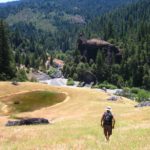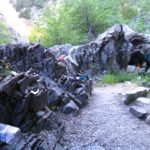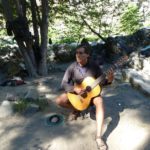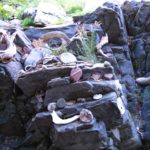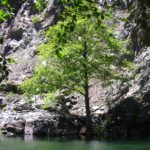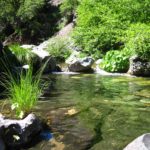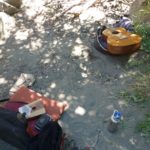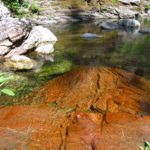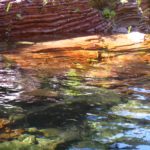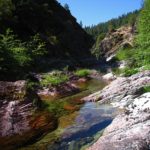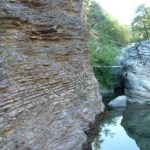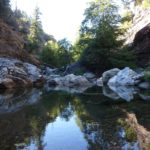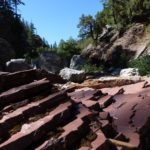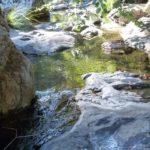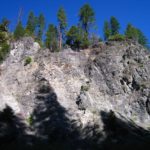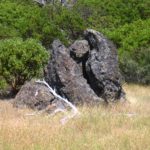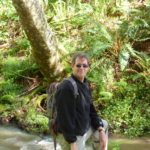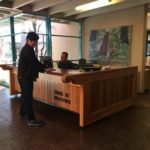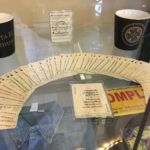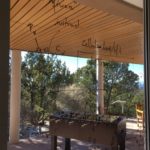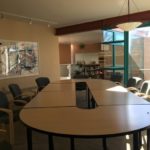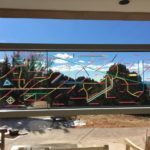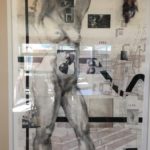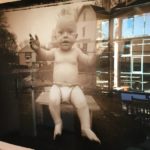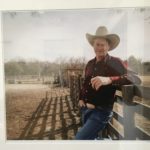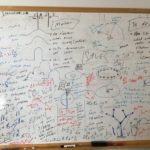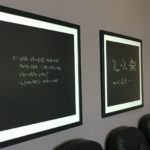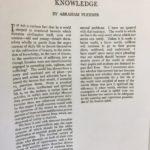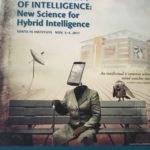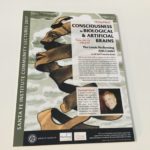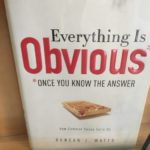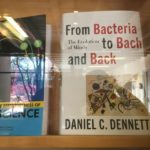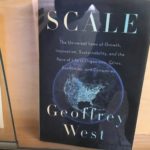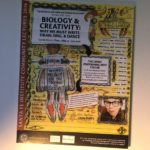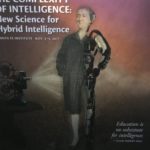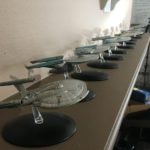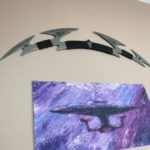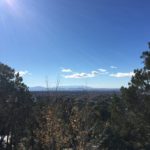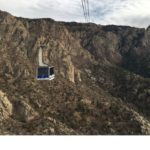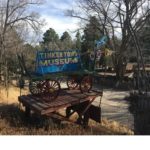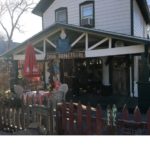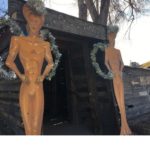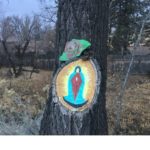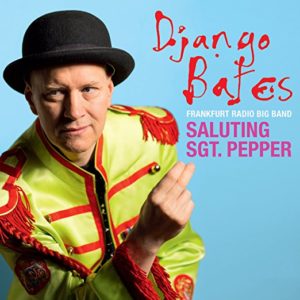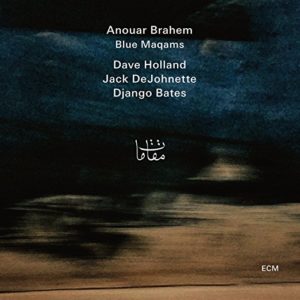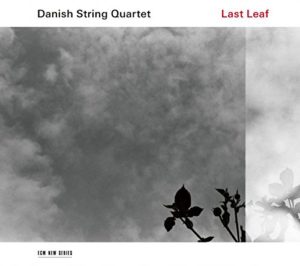[Suggestion: Try reading this piece while listening to the MP3, (with headphones if possible,) which although recorded in my studio, is typical of the kind of atmospheric free Eel River music we play down in the Yolla Bolly.]
“The trouble is, you think you have time.” — Jack Kornfield
Every year for more than a decade, my best friend/music partner and I have gone backpacking into the Yolla Bolly Wilderness region, a stretch of some 284-square miles of open country nestled deep in the Mendocino National Forest in northern California. My friend Pablo, a classical guitarist and singer who teaches music in elementary schools in the Bay Area, makes his home in the Bolly for a month nearly every summer to clear his head. He makes multiple trips down to the middle fork of the Eel River, where he sets up a luxurious campsite, complete with beach guitar, chairs, novels, sheet music, and plenty of amenities. There he practices Bach and composes with nothing but the river as his accompanist. When he is not practicing, the silence is only broken by the occasional sweet falling song of a bird calling in the wee hours of the morning and again at dusk.
About halfway through his solo trip, I come up to meet him in the little, colorful, sun-drenched town of Covelo, where the residents are a mix of Native Americans, hippies, and farmers. There we stock up on supplies at Keith’s Market before heading into the forest. It’s a 10-mile drive to the fire road, and then, to get to the trailhead, another 25 miles or so of rutted dirt roads, so funky that without four-wheel drive, one must go no faster than 15 mph – any attempt to drive faster will undoubtedly result in a flat tire. (I speak from experience.)
The drive in is breathtaking. Leveling off at around 4000 feet, the road winds through steep back-country, a near straight drop on one side revealing open land and distant mountains covered in fir and pine. Except for the rare lake, it’s a dry, rocky, and foreboding world.
Our ritual is always the same: We camp close to the trailhead the first night, grill some fresh chicken or salmon and veggies, and drink a cold bottle of Chardonnay. After breakfast we trek down to the river before the sun gets too high.
The walk to the river isn’t really that bad for a couple of older guys, even those with full packs and hangovers. A fire road for the first several miles, the trail to the river becomes a series of switchbacks straight down to the campsite. Across the river, rocky canyon walls dotted with trees reach straight for the sky. The river isn’t too wide here, no more than 30-feet across. Lush water plants and smooth rocks create small eddies, transforming the area into a peaceful sanctuary. Surrounding the campsite on two sides are low rock walls, which provide protection from the river as well as convenient food-preparation areas and a natural built-in fireplace. With its shade tree and sandy ground, it’s an ideal spot to pitch a tent.
Once we settle in, the routine is a simple, relaxing one: It’s often cold in the morning, so upon rising we don our down jackets and long underwear, get a fire going, and heat up water for coffee. The usual jokes are made after the previous night’s meal of notorious Indian Tasty Bites. I remark that the brand name of Pablo’s sleeping bag, “Windy Pass,” is apt. Soon we are sipping mugs of hot coffee and dipping spoons into bowls of oatmeal sprinkled with nuts and raisins. We are old friends and happy campers.
A typical day goes like this: For a while, Pablo will practice classical guitar while I tune up my chromatic thumb piano. Then we will dutifully head over to the sunny beach with the swimming hole next door. We will bring camp chairs, towels, a camp stove (to make a fresh pot of coffee later in the day), and a bag of biscotti, special treats crafted at the legendary Wild Flour Bakery. They are like the elven Lembas bread in Lord of the Rings: They seem to last forever and provide spiritual if not actual physical nourishment.
The rest of the day will be spent alternating between sunning ourselves on the beach, playing spontaneous kalimba and guitar duets in the shade, gazing at the “Tree of Life” (a vibrant tree that grows by the river and brims over with life force), napping, snacking, and doing yoga on the sand. Rinse and repeat. It is a good way to spend one’s time. All too soon, the sun will set over the top of the canyon, and we will head back to our campsite to make a fire and dinner. More jamming around the fire ensues before we head to bed.
Over the 15 years we have been visiting the area, there have been many day hikes. There are miles and miles of beautiful river and beaches to explore, not to mention mountain trails. Just upriver are multicolored fudge-cake layers of rock that hug the riverbank, and mysterious “moon-rocks,” sculpted over time by cascading waters, which create miniature pools that feed into a series of waterfalls—a natural fairyland.
Occasionally, we run into wildlife. One hot afternoon, while exploring, we came across a hidden pond in the woods, its surface covered with green algae and lily pads. Right in the middle of the water was a black bear, peacefully soaking, his head and shoulders exposed and eyes closed. We left quietly so as not to disturb his meditations.
Over the years, we came to think of the Yolla Bolly as our backyard and playground. Of course we were aware that it is, after all, wilderness. But we had grown to know it so well, we became inured to its very real dangers. Rattlesnakes are commonly found all over the area, and one has to be especially careful when climbing the rocks that a handhold isn’t a resting place for a sleeping viper. And then, one could conceivably fall and break a leg—it would be tough to get out of there. It is never a good idea to become complacent in such a place.
Just one year prior to the events laid out here, I was reminded that one must remain alert. I was driving behind Pablo on that 25-mile stretch of bad road and was almost to the campsite when, for some reason, I decided I simply had to check the title of a track off of Foxtail Brigade’s Bread and the Bait album. I steered towards the hill side of the road as I looked down to the display on my stereo. All of a sudden the car jolted and I heard a loud crash as the front of the vehicle dropped several feet and the car came to an abrupt halt. The road had quickly narrowed, and I had driven directly into a deep ditch. The car was stuck and had sustained serious damage; it wasn’t going to come out without assistance.
Eventually Pablo got the idea something was amiss and returned. We had to drive all the way out that night and camp in a public campground just across from the park entrance. The Coleman stove wasn’t working, so we ate a cold dinner. Then, in the middle of the night the campground sprinklers turned on, waking us and soaking us to the bone. We laughed at the absurdity of it of all. Suddenly, we were in a Chevy Chase movie.
The following morning I discovered AAA had a new policy: Their tow trucks would now only go 100 feet off the paved road. In desperation, I called unaffiliated towing companies in the area and received quotes of $1,500-$2,000 to retrieve my battered vehicle. Disheartened, we headed over to the ranger station in Covelo, where a tough Native American park ranger got on the phone with the local AAA boys and gave them a piece of her mind. Next thing I knew two cowboys showed up with a tow truck, leaving us in a cloud of dust. By the time we returned to my car, they had already pulled it out of the ditch.
All of which is to say, the Bolly is not your average backyard.
Two summers ago we were down in the Bolly doing our usual thing, when we decided to take an adventurous hike to Wright’s Valley, some 6 miles away. A fleet of fluffy white cumulus clouds was quickly moving east across an indigo sky as we made our way upriver. The weather changes quickly in the Bolly, but it was completely still down by the water. After making a right turn at a nearby fork, wading through neck-high waters, Pablo decided to take a short cut up the side of the canyon to a trail that ran parallel to the river. It was a steep climb, but there were plenty of trees and boulders to hang onto. Once we got to the top of the ridge, we began hiking high above the river.
There had been extensive wildfires through the region a few years back, barring us from entry to the Bolly for a couple summers until the area recovered. Trails in the Bolly are sketchy at best, and signage is rare. The fires had obliterated the few remaining signs, and the undergrowth that had grown back had totally obscured the trails; we were basically bushwhacking. Most of the trees were dead and blackened; it was a bleak and unwelcoming landscape. As the afternoon wore on, I began to feel fatigued. I was trying to avoid two scarred branches when I slipped and stumbled, finding myself awkwardly pinned between them. I barely avoided being impaled by a sharp branch. My leg, however, had fared less well: I had sustained long lacerations along my left thigh and calf. I rinsed the dirt off my wounds with drinking water, and we trudged on.
Soon it became apparent we weren’t going to make it down to the valley, now plainly visible in the distance. The cool beaches and idyllic swimming holes Pablo had been waxing rhapsodic about would have to wait for another day. It was getting late, and we still had a long trek back. Due to the ongoing drought, the springs we encountered were muddy and clogged our already failing water filter. It was hot, and we had used most of our drinking water. Now there would be no more until we got back down to the river.
We were faced with the choice to either backtrack via a long trail down to the river—a route that led away from our site—and then river-walk home, or try to find the same shortcut we had used on the way up. We chose the latter. Pablo, who had uncharacteristically swallowed a small cannabis brownie that morning (an activity usually reserved for our more stationary river/jam afternoons), seemed a bit confused as to its precise location.
We walked over to the side of the canyon to get our bearings. Directly below us stretched a nearly featureless wash, a 200-foot wide, steep, sandy ravine dotted with clumps of low-lying scrub. For no apparent reason, a strange sense of misgiving came over me. Before sitting on the edge of the ravine, I said out loud, mostly to myself, “Well, if I’m going to die out here, at least I’ll get in a good piss first.” After relieving myself, I shambled back to the edge of the wash where Pablo was sitting. Together we surveyed the desolate landscape below. Devoid of trees, the steep ravine underscored the depth of the canyon. The river looked very far away.
While sitting on the edge of the ravine, still engaged in a heated discussion as to the whereabouts of the shortcut, without warning, the parched ground beneath me literally cracked and gave way; a low branch I had been holding onto for support snapped, and I was sliding down the ravine on my butt, still holding onto the broken branch. It all happened so fast I didn’t have time to feel fear or think. The only thought going through my head was “tree.” Because the wash turned out not to be entirely featureless after all: For the first time, I registered a young pine tree, no more than 2 1/2 feet in diameter and about 100 feet below me. And I was heading directly for it. It was almost as if the tree had been standing sentry all these years, patiently waiting to receive me. I was picking up speed rapidly by the time I hit the tree trunk dead on, feet first. I watched as stones, sand, and debris I had dislodged continued their descent down the ravine, smashing against the rocks below.
I surveyed my surroundings, looking down first at what would’ve awaited me had the tree not broken my fall. About halfway down lay rows of large, toothy rocks; they would’ve nicely tenderized me as I accelerated toward the tangle of sharp branches and boulders strewn about at the river’s edge. To my left was a long stretch of unbroken slippery sand that ran for at least 150 feet. No escape that way. To the right, nothing but more sand and a small, scrawny baby pine tree about 8 feet away. Beyond the sapling lay a spiky, dead fir tree facing down the mountain some 15 odd feet further away from it. I was safe for the moment, but what to do? I couldn’t stand up in the sand; it was so fine it would immediately uproot me and send me down the ravine.
Pablo was above me, frantically running back and forth, trying to figure out a passage down. After a while he disappeared. It was quiet. All I heard was the high wind and the faint sound of the water below. A kite flew overhead, his white belly exposed, calling out just once before swooping down to the river to hunt. I pulled out my water bottle and took a long drink. I was already very dehydrated. I ate the other half of the apple I had left in my daypack; I had brought no other food. The sun was still hot, and I felt my legs baking. I dug in my backpack and applied sunscreen to my arms and legs as I waited. If I was going to fall to my death, at least I wasn’t going to have a sunburn.
Suddenly, Pablo appeared, scrambling down the fallen tree. We chided ourselves for not bringing a rope with us—what little rope we had was back at camp. He suggested a jump. “I don’t want to die out here, man,” I said. As far as I was concerned, it seemed the most prudent thing to do was to stay put. “I could head back to camp, get both ropes, tie them together and pull you out,” Pablo offered. I declined, partially because by the time he got back, we would’ve lost the light. I also knew Pablo’s knot-tying lore left something to be desired. The only other option would involve Pablo heading back to our campsite, hiking all the way back up to the car, and driving out. He would have to camp out somewhere overnight, and head over to the Ranger Station in Covelo the next morning with the intent to bring a ranger in to help pull me out. For a moment, I had a vision of the tough bespectacled Native American ranger, who had helped us with the tow truck coming to my rescue in her crisp unwrinkled uniform, throwing down a rope from the top of the trail, and single handedly pulling me out, all the while chastising me in her no nonsense voice for being stupid enough to get myself into this predicament in the first place.
But that plan would require me staying put on that tree overnight and at least throughout most of the next day. It got down to the low 40s at night and I had no jacket, just the short-sleeved shirt and shorts I was wearing. And what if I fell asleep? I could easily wake up hurtling down the ravine.
It was getting late and a decision was finally made: Pablo would go back to the campsite and grab the rope. He would hopefully return in time to pull me out before dark, that is, if he could find me. Just as he disappeared from sight, a part of me screamed, “I want this to be over now!” I looked to my right and once again noticed the small, spindly pine tree: It was only about 3 feet high and no more than 4 or 5 inches in diameter. Could it hold me? Without thinking, I jumped to it and just barely grabbed it. I pulled myself up, and tenuously straddling the scrawny sapling, shouted, “Pablo, I jumped to the little tree!” Footsteps, scrambling, and then Pablo reappeared on the downed tree. “Alright,” he said breathlessly. “ Now we are going to get you out of here.”
I had jumped—I had committed. There was no way I could hang on to this tiny tree overnight. After taking stock of the situation, Pablo pointed to a small, damp patch in the sand, about halfway to the downed tree. He suggested I jump to it and push off from it to the fallen tree. It was quite a leap and I wasn’t sure I’d make it. But I knew I couldn’t stay where I was.
After some 10 minutes of terror-induced paralysis, I summoned enough courage to make the jump. I pushed off with my left foot from my perch on the small tree and hit the damp spot dead on, pushing off of it with my stronger right leg. I fell short of the dead tree and began to slip downhill. Pablo had climbed to the edge of a branch of the fallen fir tree and was leaning all the way out with his arm outstretched. I reached out and felt the firm grasp of his extended hand. His grip seemed to say, “No way am I going to let you go.” He pulled me to safety.
Hand over hand, we climbed up the dead tree. But there was no safe passage to the top – how Pablo had gotten to the downed fir tree still remains a mystery to me. (I do know he injured himself in the process and limped for several months after the ordeal.) We were going to have to hike horizontally across the ravine until a way up revealed itself. We crawled on our bellies along a sandy stretch, holding onto low-lying scrub. At the end of the line of brush, Pablo tried to stand—instantly, his feet went out from under him. He would’ve plummeted down the ravine had he not grasped onto a nearby bush, which barely held as he repositioned himself on the slippery ground. He stood up once again, this time jumping from one small rock to another, successfully clearing the sandy strip. I followed his footsteps to safety. We found ourselves in a field of flat slate rocks and began to slowly climb up to the trail. At the very top, the hill became nearly vertical. Pablo grabbed onto the black, flat rocks embedded in the hillside and pulled himself up to the trail. I followed suit. “Climb like a monkey. Use all your limbs,” Pablo said encouragingly. Just then, one of the rocks I was using as a handhold came out of the hillside – I was falling backwards. I dropped the rock just as Pablo reached out his hand to grab mine and pulled me up to the trail. We were finally safe.
We walked in silence towards the trail down to the river, away from camp: There would be no more attempts to find the shortcut today.
After entering a wooded area, we came to a small forest clearing. Late afternoon sunlight dappled the trees and the verdant forest floor. The middle of the clearing was covered in long, deep-green grasses, and we heard the sound of running water. We had found a spring! Pablo pulled out the pump and managed to get it working. As we sat and drank the cool water in the peaceful glade, a thought came to me. “Pablo, what if I’m in a ‘he’s already dead’ movie, you know, like in The Sixth Sense or Jacob’s Ladder, and this is just my weird dream as I leave my body?” “Then, why am I here?” Pablo shot back. A few moments went by in silence. “Do you think I would’ve lived had I missed the tree?” I asked. “You might’ve lived, but if you had, you probably would’ve wished you hadn’t,” he responded tersely.
The walk back was difficult in the failing light. We must’ve walked right past the bottom of the ravine above which I had been marooned only a couple hours before. So intent upon getting back to camp, neither of us thought to stop to get a view of it.
By the time we returned to our campsite, it was already dark. We were famished and ate an early dinner. As we played music around the campfire, I felt grateful and happy to be there, instead of on the side of a cold, lonely mountain. A few minutes later, the sky opened up, and we were caught in a torrential downpour. Laughing, we scurried to our tents, hastily put up our rain flies, and went to bed. I couldn’t sleep and lay there for a long time, listening to the rain. Every once in a while a large rock would dislodge itself from the canyon wall and come tumbling down, crashing into the river. My thoughts kept returning to the moment the ground went out from under me; this time in my mind’s eye I missed the tree, and watched helplessly as I tumbled all the way down to the boulders and scattered broken limbs below. I relived the incident several times before drifting off to sleep.
When I came out of the Bolly a couple days later, I was a changed man. I felt a renewed joie de vivre that had been missing from my life for a long time. I felt more willing to take risks and be more courageous and open to life. I made sweeping resolutions: I would start afresh with projects I had put on the back burner for years. I would write more music and finish my next album, write more stories, love my family more deeply and be a better partner, a better friend.
I tried to hold on to this renewed resolve, and for a little while I was truly happy just to be alive. But not long after, the vivid memory of the event began to fade, and I gradually returned to my habitual neutral state. I went back to my old ways of procrastination and self-doubt; the vague sense of dissatisfaction that had haunted me most of my adult life returned.
So If I didn’t stay a changed man, what real impact, if any, did the experience have on me? When I was stranded on the tree, it was like getting a whiff of cosmic smelling salts. There’s nothing like the threat of losing everything—and having your best friend save your life—to wake one up to the importance of love, connection, and community.
At my best moments, I let that knowledge inform my interactions with my partner, family, and friends, and when I remember, even the girl at the checkout counter. I may have lost the depth of the experience, but not the message.
Mundane life has a way of reasserting itself. This is what it’s like to be human. Yet “between the forceps and the stone,” the way we spend that short span is entirely up to us. The rest is grace.
Note: the mp3 is of the first time we attempted to record one of our free „river jams“ in my studio. We had just returned from one of our trips, and Pablo had just gotten his new custom guitar. There are now dozens of such recordings, vastly improved in both quality of performance and recording techniques, but despite its rough edges, this one perhaps best captures the spirit of what we actually do by the river, albeit played on much nicer instruments. For this recording, I’m playing an Array Mbira, a 4 octave, 128 note chromatic instrument built by Patrick Hadley and designed and tuned by Bill Wesley. For more information, please visit www.arraymbira.com
Pablo’s classical guitar was built by Richard Prenkert, Sebastopol CA.
